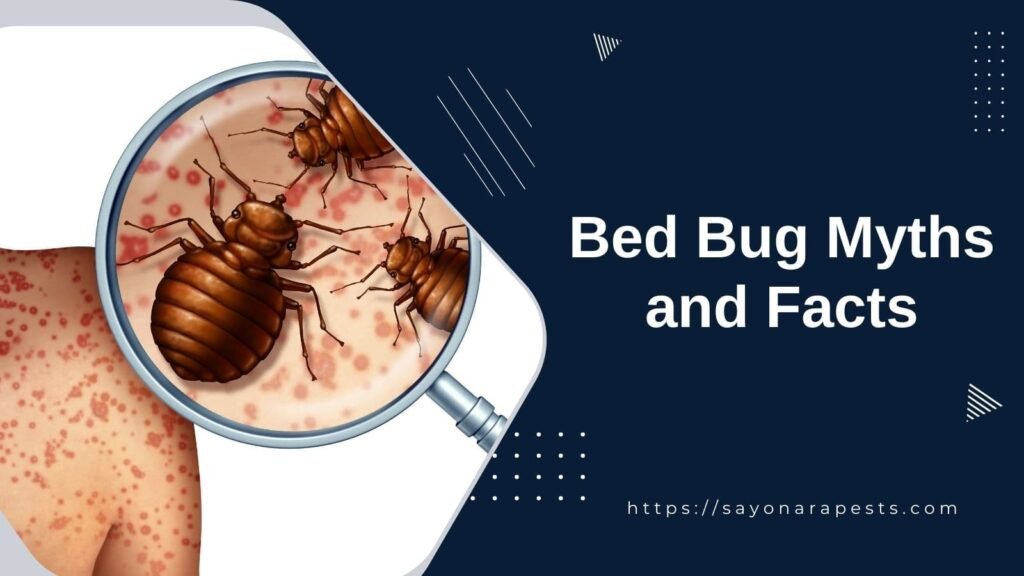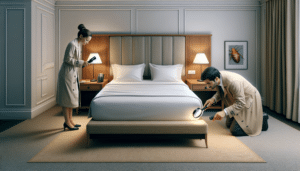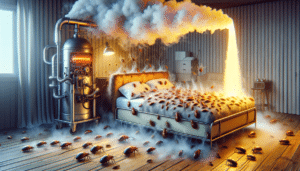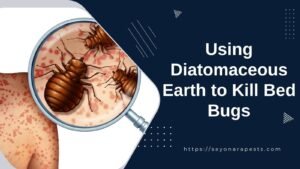Getting to Know Bed Bugs
Dealing with bed bugs can be a real headache, but understanding their quirks can make a world of difference. Whether you’re a homeowner, hotel manager, or renter, knowing what makes these critters tick can help you spot, stop, and manage them better.
What Bed Bugs Do
First off, bed bugs can’t fly. They’re wingless and can only crawl about a meter a minute. Fun fact: if you use a blow dryer, you can blow them about 1.2 meters, but that’s not their usual way of getting around.
These little vampires are night owls, coming out to feed when it’s dark. But if they’re hungry, they’ll bite during the day too. So, leaving the lights on won’t save you from their bites.
Where Bed Bugs Hang Out
Bed bugs are tiny, about the size of an apple seed when fully grown. They can live in a wide range of temperatures, from 46 to 113 degrees Fahrenheit. They love to stay close to where you sleep, usually within eight feet of your bed.
They don’t jump from person to person like fleas. Instead, they hitch rides on your clothes or luggage, sneaking into new places without you noticing. They spread slowly by crawling, but they can move faster through walls and pipes in buildings.
These pests have been bugging humans for over 3,300 years. They’re not picky about where they live as long as they can find a blood meal. You’ll find them in homes, hotels, schools, offices, and even on public transport. While they prefer human blood, they’ll also feed on other warm-blooded animals.
Knowing these habits can help you keep bed bugs at bay. If you’re traveling, take extra care to check your hotel room. And if you’re dealing with an infestation, there are plenty of DIY and professional treatments to explore.
Spotting Bed Bug Infestations
Catching bed bugs early is crucial to stopping them from spreading and making sure you can get rid of them for good. Whether you own a home, run a hotel, or rent an apartment, you need to keep an eye out for these sneaky pests.
Clues Bed Bugs Leave Behind
Bed bugs aren’t exactly shy about leaving evidence. Here’s what to look for:
- Fecal Spots: Tiny reddish-brown stains on mattresses, furniture, or walls.
- Shed Skins: These are the old exoskeletons of bed bugs, looking like small tan flakes.
- Live Bugs: These critters are oval and flat, reddish-brown before they eat, and swollen and dull red after a meal.
Here’s a quick reference table:
| Sign | Description |
|---|---|
| Fecal Spots | Reddish-brown stains on fabric or walls |
| Shed Skins | Old exoskeletons of the nymphs |
| Live Bugs | Flat, reddish-brown insects before feeding; swollen and dull red after |
For more on bed bug habits and how to spot them, check out bed bug myths and facts. If you find signs of bed bugs, it’s best to look into professional bed bug treatment options since these pests are tough to get rid of.
Spotting Bed Bug Bites
Bed bug bites can look a lot like mosquito bites, so they’re easy to mix up. Here’s how to tell:
- Where They Bite: Usually on exposed skin like arms and legs.
- What They Look Like: Welts or rashes that can itch.
- Varied Reactions: Some people don’t react to bed bug bites at all, so bites alone aren’t a sure sign.
Bed bugs need blood to live, and they use a needle-like mouthpart to pierce the skin, making their bites look like those of other insects. Because some folks don’t react to the bites, you should look for other signs too.
If you think you’ve been bitten, check for other signs of bed bugs and consider methods like using steam to kill bed bugs or using diatomaceous earth to kill bed bugs.
For more tips on dealing with bed bug bites, see our guide on ways to kill bed bugs. If you’re still unsure, get in touch with a pest management pro to confirm if you have bed bugs and talk about the best bed bug elimination techniques.
Keep Bed Bugs Out: Simple Tips and Tricks
Nobody wants to share their home with bed bugs. These little pests can be a real headache, but with a bit of effort, you can keep them at bay. Here’s how to stay one step ahead of bed bugs and keep your home bug-free.
Smart Tips to Keep Bed Bugs Away
Bed bugs are sneaky, but you can outsmart them. Here are some easy and practical tips to keep them from moving in:
- Inspect Regularly: Check your bedroom, especially around and under beds and furniture, for any signs of bed bugs.
- Protect Your Mattress: Use covers on mattresses and box springs to block their favorite hiding spots.
- Declutter: Less clutter means fewer places for bed bugs to hide.
- Vacuum Often: Regular vacuuming can help get rid of any bed bugs on the floor, baseboards, or carpets.
- Wash Bedding: Clean your bedding and curtains in hot water and dry them on high heat to kill any bed bugs.
- Seal Cracks: Close up any cracks in walls, floors, and around baseboards and outlets to keep bed bugs from sneaking in.
When buying used furniture, be extra careful. Check everything thoroughly before bringing it into your home to make sure it’s bed bug-free.
If you’re dealing with an infestation or want to learn more about getting rid of bed bugs, check out our guides on killing bed bugs with heat, using steam to kill bed bugs, or using diatomaceous earth to kill bed bugs.
Travel Tips to Avoid Bed Bugs
Traveling can sometimes mean running into bed bugs. Here’s how to avoid bringing them home with you:
- Check Hotel Rooms: Look for signs of bed bugs in hotel rooms, especially around the bed, mattress, headboard, and box spring. Our guide on how to check for bed bugs in hotel rooms has all the details.
- Keep Luggage Off the Floor: Use luggage racks or place your bags on a hard surface or in the bathroom.
- Use Hard-Shelled Suitcases: These are harder for bed bugs to get into compared to fabric ones.
- Seal Your Clothes: Store your clothing in sealable plastic bags to keep them safe from bed bugs.
- Unpack Carefully: When you get home, unpack directly into the washing machine and wash everything in hot water, then dry on high heat.
- Vacuum Your Suitcases: Give your suitcases a good vacuum and store them away from bedrooms.
By following these tips and staying informed, you can keep bed bugs out of your home.
For more strategies on preventing bed bugs when traveling or what to do if you think you have an infestation, check out our resources on preventing bed bugs from spreading and professional bed bug treatment options.
DIY Bed Bug Control Methods
Dealing with bed bugs can be a nightmare for homeowners, renters, and hotel managers alike. But before you call in the pros, there are some DIY tricks you can try to tackle these pesky critters.
Bed Bug Interceptor Traps
Interceptor traps are a simple, chemical-free way to catch bed bugs. These traps go under the legs of your furniture, creating a moat that bed bugs can’t cross. When they try to climb up, they fall in and can’t get out.
You can buy these traps or make your own. The EPA has some handy tips on how to build and use them. Not only do these traps help reduce the number of bed bugs, but they also let you see if your efforts are working.
Here’s a quick guide to setting up interceptor traps:
| Step | Action |
|---|---|
| 1 | Get or make bed bug interceptor traps. |
| 2 | Place them under all furniture legs. |
| 3 | Check them regularly for trapped bugs. |
| 4 | Clean and reset as needed. |
Getting Ready for Treatment
Preparation is crucial when you’re dealing with bed bugs. Proper prep makes sure the treatment reaches all the nooks and crannies where bed bugs hide. The EPA stresses the importance of cleaning, decluttering, and sometimes even taking apart furniture.
Here’s how to get ready:
- Wash all your bedding, curtains, and clothes in hot water. Dry them on the highest setting. For items that can’t be washed, just toss them in the dryer on high for 30 minutes.
- Scrub mattress seams with a stiff brush to knock loose any bugs and eggs.
- Vacuum your bed and the area around it often. After vacuuming, seal the vacuum bag in a plastic bag and toss it in an outdoor trash can.
- Encase your mattress and box springs in a tightly woven, zippered cover. Bed bugs can live up to a year without feeding, so keep the cover on for at least a year to make sure they’re all dead.
- Fix any cracks in plaster and glue down peeling wallpaper to get rid of hiding spots.
- Clear out clutter around your bed.
By following these steps, you can boost the effectiveness of DIY methods like using diatomaceous earth, steam, or heat treatments. Keep in mind, though, that DIY methods might not always do the trick. If the problem persists, consider professional bed bug treatments.
Professional Bed Bug Treatments
Got bed bugs? Yeah, they’re a nightmare. But don’t worry, professional treatments can kick those pests out for good. Experts come armed with know-how, fancy tools, and top-notch treatments you can’t get at the store.
Pest Control Services
Pest control pros offer a full-on assault against bed bugs. They start with a thorough inspection, then whip up a game plan just for your situation. This might mix and match different methods to make sure those bugs are history. If your DIY attempts have flopped, these folks are your best bet.
Here’s what they do:
- Inspection and Monitoring: They’ll scope out the problem and keep tabs on it.
- Chemical Treatments: They use powerful insecticides that zero in on bed bugs.
- Heat Treatments: They crank up the heat to levels that bed bugs can’t survive.
- Preventative Measures: They set up defenses like mattress covers and traps to keep bugs from coming back.
Want the full scoop on what the pros do? Check out professional bed bug treatment options.
Chemical Treatments
Chemical treatments are a big part of the bed bug battle. Pros have access to super-strong insecticides that last longer than the stuff you can buy. They use:
- Liquids: Sprayed right where bed bugs hide.
- Dusts: Perfect for cracks and crevices.
- Aerosols: Great for tight spots and tricky furniture.
Make sure your pest control service uses safe practices and follows local rules to keep everyone, including pets, safe. Ask about the insecticides they use and any prep work you need to do.
Professional treatments usually need follow-up visits to make sure every last bug is gone. They might need to hit the place again if any bugs survived the first round. Keeping an eye on things after treatment is key to making sure the bugs don’t come back.
If you’re not into chemicals, pros also offer killing bed bugs with heat or using steam to kill bed bugs. These methods are great for sensitive areas or if you just want to avoid insecticides.
Bed bugs are tough to beat, but professional pest control services have the tools and tricks to get the job done. If you think you’ve got an infestation, calling in the pros can save you time and hassle, and give you peace of mind.
Tackling Bed Bug Infestations
Dealing with bed bugs isn’t a one-and-done situation. It takes a few steps, some patience, and a keen eye to make sure these pests are gone for good. Sometimes, you might need to go through the process more than once, and keeping an eye out for any signs of their return is crucial.
When to Retreat
After your first attempt to get rid of bed bugs, whether you did it yourself or hired a pro, you need to stay alert.
The EPA says success depends on how many bugs there are, where they can hide, and how well everyone in the house cooperates. You might need to retreat if:
- You still see live bed bugs after the first treatment.
- There are new signs of bed bugs, like fresh bites or droppings.
- Eggs have hatched since the last treatment because they’re tougher to kill with pesticides.
If you need to retreat, you might want to try different methods. For example, killing bed bugs with heat or using diatomaceous earth can be good alternatives to chemicals.
Keeping an Eye Out
After treatment, you’ve got to keep checking to make sure the bed bugs are really gone.
The EPA recommends looking for signs of bed bugs every few days. This means:
- Checking places where bed bugs like to hide, like mattress seams, bed frames, furniture, and behind baseboards.
- Looking for signs like bed bug skins, eggs, or droppings.
- Noticing any new bites or skin reactions.
Staying vigilant with post-treatment monitoring can stop future infestations. Using things like mattress covers and interceptor traps can also help.
For more tips on keeping bed bugs away, check out our guides on preventing bed bugs from spreading and bed bug prevention when traveling.
If you keep seeing signs of bed bugs after several treatments, it might be time to call in the pros for a more aggressive approach. Check out our guide on professional bed bug treatment options for more help.




